
RESTORED: 2/25/22
Tags: Study of Lightning, Weaponized Lightning, Weather Manipulation, Types of Civilizations, Geo-Engineering, NASA, Department of Defense
I know that Americans especially have a hard time imagining that our leaders could really be horribly evil creatures out to destroy us. Wow, that is a hard pill to swallow. But, hiding our heads and hoping it all goes away will not help your children and grand children survive, let alone have a future. You must listen to what these people say. They keep telling you how evil they are… but you just slough it off. PAY ATTENTION!!
These “scientists” are hellbound to push the limits. They are seeking POWER and CONTROL. They really don’t care how they get it. They don’t care from whom they get it. They don’t care what it costs or how many lives will be destroyed.
They not only want to control us, they want to control EVERYTHING! They want the power of the gods! Control of all energy, all life. They want the power of FIRE and LIGHTNING!
Michio Kaku
“A Type-1 civilization has harnessed its planetary power. They control earthquakes, the weather, volcanoes, they have cities on the ocean, anything planetary – they control “
Richard Seed
“We are going to become Gods period. If you don’t like it, get off. But, if you are going to interfere with me becoming God, we’re gonna have big trouble. We will have warfare. The only way you can prevent me in this is to kill me, you kill me, I will kill you.
Elon Musk
“I think we should be very careful about artificial intelligence. If I were to guess like what our biggest existential threat is, it’s probably that. So we need to be very careful with the artificial intelligence. Increasingly scientists think there should be some regulatory oversight maybe at the national and international level, just to make sure that we don’t do something very foolish. With artificial intelligence we are summoning the demon. In all those stories where there’s the guy with the pentagram and the holy water, it’s like yeah he’s sure he can control the demon. Didn’t work out.”
Sergio Bertolucci, director for research : scientific computing at CERN, regarding dimensional doorways they are opening:
“Out of this door might come something, or we might send something through it.”[i]
TO play with fire To do something that risks causing one harm, damage, or misfortune; to do something dangerous. They’re playing with fire if they think they can get away with dodging these corporate taxes. Jen swears she’s being safe when she experiments with drugs, but I think she’s playing with fire.
Playing with Fire – Idioms by The Free Dictionary
THAT IS EXACTLY WHAT THESE FOLKS ARE DOING!! LITERALLY PLAYING WITH FIRE AT OUR EXPENSE!
Update: 7/12
I came across this video on one of my posts regarding the Paradise Fires. It is very much related to this article so I decided to add it. Take a look at the POWER of the LASER DIRECTED ENERGY BEAM.
spacer
I happened to be watching a video when the host made a statement that hit me. I have captured just that portion of his video below. Listen
Caught On Camera! Prehistoric Creature Pterodactyl Escapes Through Portal Caused By Lightning Strike
Remember, Satan/LUCIFER is the Prince of the POWER OF THE AIR. Anything that cuts through the air affects the spiritual realm. That is the power of prayer and praise and worship. In spiritual warfare, there is a purpose in clapping our hands. CLAPPING and SLAPPING A FLAG/BANNER in the AIR impacts the spiritual realm and brings power to your words/intent.
I can’t tell you how I learned that right now, this post is already too long. Suffice it to say that GOD taught about BANNERS and SPIRITUAL WAREFARE.
So when I heard the guy say that THUNDER was the CLAP of the air closing back what was sliced by the lightning it got my attention. It motivated me to create this post.
TESLA – MASTER OF LIGHTNING [DOCUMENTARY 2000]

spacer
Data from the International Space Station confirms lightning is insae …
Earth’s Science – A ‘blue bang’ sparks an unusual type of lightning in the upper atmosphere…
After learning more about Lightning… I am getting an even clearer picture of what Scientists are up to with the stuff that they are putting up into our atmosphere and beyond. Check out these articles:
It’s All SMOKE AND MIRRORS!!!
Heat, lightning, drought create perfect storm for record California Fires…
Lightning
In mid-August, a series of freak summer storms blasted California with more than 14,000 lightning strikes and almost no rain. More than one-third of all the acres that have burned this year came from that lightning.
“I’ve never seen a lightning storm come in and have a bull’s-eye on the greater Bay Area and beyond. It’s extraordinarily rare,” said Scott Stephens, a fire scientist at the S of California at Berkeley. “It overwhelms all the fire management agencies we have.”
spacer
Study: How Sun influences lightning and thunder activity on earth …
spacer
Where in the World Does Lightning Strike the Most?
In a new study using 16 years of satellite data, NASA reveals that the number one spot gets almost 300 thunderstorms per year; these other hotspots are wild as well.
“We can now observe lightning flash rate density in very fine detail on a global scale,” says Richard Blakeslee, LIS project scientist at NASA’s Marshall Space Flight Center. “Better understanding of lightning activity around the world enables policy makers, government agencies and other stakeholders to make more informed decisions related to weather and climate.”
(So we see here that they are admitting to at least 20 years to date of studying Lightning where and when it hits, how it is formed, how it is directed and how to create it.)
spacer
California fires: This is how a lightning storm can start …
After a long, dry summer, it takes only one spark to bring on a flaming disaster.
spacer
Colorado wildfires: lightning poses threat to starting new …
Scientist: Carbon Dioxide Doesn’t Cause Global Warming
A noted geologist who coauthored the New York Times bestseller Sugar Busters has turned his attention to convincing Congress that carbon dioxide emissions are good for the Earth and don’t cause global warming. Leighton Steward is on Capitol Hill this week armed with studies and his book Fire, Ice and Paradise in a bid to show senators working on the energy bill that the carbon dioxide cap-and-trade scheme could actually hurt the environment by reducing CO2 levels.
Much of the global warming debate has focused on reducing CO2 emissions because it is thought that the greenhouse gas produced mostly from fossil fuels is warming the planet. But Steward, who once believed CO2 caused global warming, is trying to fight that with a mountain of studies and scientific evidence that suggest CO2 is not the cause for warming. What’s more, he says CO2 levels are so low that more, not less, is needed to sustain and expand plant growth.
Trying to debunk theories that higher CO2 levels cause warming, he cites studies that show CO2 levels following temperature spikes, prompting him to back other scientists who say that global warming is caused by solar activity.
In taking on lawmakers pushing for a cap-and-trade plan to deal with emissions, Steward tells Whispers that he’s worried that the legislation will result in huge and unneeded taxes. Worse, if CO2 levels are cut, he warns, food production will slow because plants grown at higher CO2 levels make larger fruit and vegetables and also use less water. He also said that higher CO2 levels are not harmful to humans. As an example, he said that Earth’s atmosphere currently has about 338 parts per million of CO2 and that in Navy subs, the danger level for carbon dioxide isn’t reached until the air has 8,000 parts per million of CO2.
Steward is part of a nonprofit group called Plants Need CO2 that is funding pro-CO2 ads in two states represented by two key lawmakers involved in the energy debate: Montana’s Sen. Max Baucus and New Mexico’s Sen. Jeff Bingaman.

Scientists think they’ve solved the mystery of how volcanic lightning forms
Apr 13, 2016April 13, 2016 at 7:33 p.m. UTC. Lightning in volcanic eruptions has been somewhat of a mystery until now. It’s not that scientists don’t know how lightning forms — charge separation
Lightning and lava. Chile volcano violently explodes in electric storm
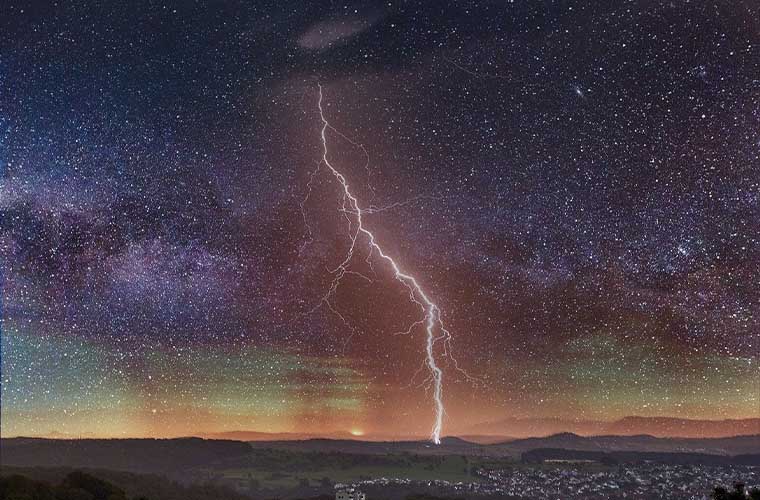
Could lightning be responsible for the origin of life on Earth? According to a new study published by researchers at Yale and the University of Leeds, yes.
In their study, published today in the journal Nature Communications, researchers contend that over billions of years, up to a quintillion lightning strikes is what unlocked usable phosphorus and ultimately sparked the creation of life on planet Earth.
“This work helps us understand how life may have formed on Earth and how it could still be forming on other, Earth-like planets,” said lead author Benjamin Hess, a graduate student in Yale’s Department of Earth & Planetary Sciences, in a press release issued today by Yale.
spacer

Scientists Say Laser Device Can Make Lightning Strike targets…

An international team of researchers says that small lasers could be used to guide lightning strikes — much like Thor’s legendary hammer Mjölnir.
“It turns out that to deliver particles, you do not need high-intensity lasers, even low intensity like your laser pointer will be already enough,” Andrey Miroshnichenko, a researcher at the University of New South Wales in Canberra, Australia, told Agence France Presse of the work.
The team says it’s already tested the concept in labs using devices known as hollow lasers, which in effect create a pipe of light. These lasers can short circuit storm clouds and trigger lightning strikes by heating micro-particles in the air.
(Well, Jimeny Pete…BATMAN… If that is true, don’t you think that all the super High Powered Electro Magnetic Beams and High Powered Lasers they have been shooting into our atmosphere is OVERKILL?? Not to mention the NUCLEAR EXPLOSIVES.)
Laser Pointers
High-powered lasers made the process not only expensive and hard to predict, but dangerous as well. (GEE, YOU THINK??) But according to new research by the team, as detailed in a paper published in the journal Nature Communications last month, the idea might work just as well using low intensity laser pointers.
Through “the use of a laser beam of a few hundred milliwatts of power,” the “discharge threshold” of electrical charges in the air could be decreased by 30 percent, the team write in their paper, allowing them to guide the lightning “along a predetermined path in the air.”
“We can imagine a future where this technology may induce electrical discharge from passing lightning, helping to guide it to safe targets and reduce the risk of catastrophic fires,” co-researcher Vladlen Shvedov from the Australian National University told AFP. (I contend that they have known this for some time and have been using the power to CAUSE the weather phenomenon and wild fires rather than to prevent them. Now, when they have destroyed everything and we are at their mercy, now they want us to see them as our heroes, saving the planet and mankind. BULLSHIT!)
Or you could use it to smite your enemies. Just saying. (Well, we know that they have already weaponized every kind of power they can.)
READ MORE: Laser-guided lightning may help prevent wildfires [AFP]
spacer
To catch a lightning bolt | Laser Focus World
(a terra watt is a TRILLION WATS)
Jun 8th, 2021
Now it’s 2021, and I’ve come across a follow-up project: a team of scientists build a laser to catch a lightning bolt. The ultrashort-pulsed laser is steered in the sky, builds a plasma channel, and that should guide the flash to a huge telecom antenna on the Swiss mountain Säntis.
The scientific leader of the project is Jean-Pierre Wolf, a professor from Geneva University and the former CEO of Elight, which was the startup that built a commercial weather lidar in the early 1990s. While he had more than 30 years of experience in atmospheric laser research, it took a laboratory accident in Michigan in 1996 to set him off onto the filament idea. (So he had 0 years of experience in laser research befor 1996) There, in the lab of Gérard Mourou and Donna Strickland, a mirror was broken and leaked intense short-pulsed laser radiation.(Please see my articles on our current telescopes) Surprisingly, this laser beam made a kind of filament in air. It was a plasma, but not limited to a focal point. They played around and created a longer filament. Then, they went out on the floor—they could tweak the laser to create a filament as long as the whole floor, which was almost 100 ft., as the legend says. At that time, they did not send it outside.
There were others who tried that—for example, in the French-German project Teramobile in 2008. They managed to trigger electrical activity in thunderclouds, but they did not succeed completely, as their plasma channel did not live long enough for “real” lightning bolt guiding. An American team from the University of Arizona (UA; Tucson, AZ) and the University of Central Florida (UCF; Orlando, FL) tried it in 2014 with a femtosecond pulse followed by a nanosecond pulse. They all had great results on a scale of a few meters in a laboratory setting, but not in free nature. A lightning bolt needs milliseconds to build up on a scale of hundreds of meters, as Jean-Pierre Wolf told me. And that has not been established—yet.
It takes a big laser to catch a lightning bolt
In 2017, the European Union granted almost €4 million to build and test a laser to act as a lightning rod. This time, they wanted to have both the high intensity of a terawatt laser and the efficient energy deposition in the plasma channel through a high average power. German laser manufacturer Trumpf (in fact Trumpf Scientific, their branch for research projects) took over the construction of the required laser. The laser delivers 720 mJ pulses at a repetition rate of 1 kHz. The pulses are in the picosecond region, creating intensities at the terawatt level in the focus.
Most pieces of the huge laser system have already been transported to the top of mount Säntis with a funicular—just the telescope waits for helicopter transport, which has been circumvented by bad weather so far. The laser will be mounted on the eighth floor of the radom building beside the TV tower and ignite the plasma filament on top of the antenna’s tip.
Experiments are scheduled for summer 2021. Will they catch a lightning bolt? Jean-Pierre Wolf said at a recent press conference, “The atmosphere is always quite different from what we have in the lab” and “we will learn a lot about lightning mechanisms.” But he is optimistic that after 25 years of attempts, it will work this time. They just have to wait for a thunderstorm. Statistically, there are more than 100 thunderstorms on mount Säntis per year.
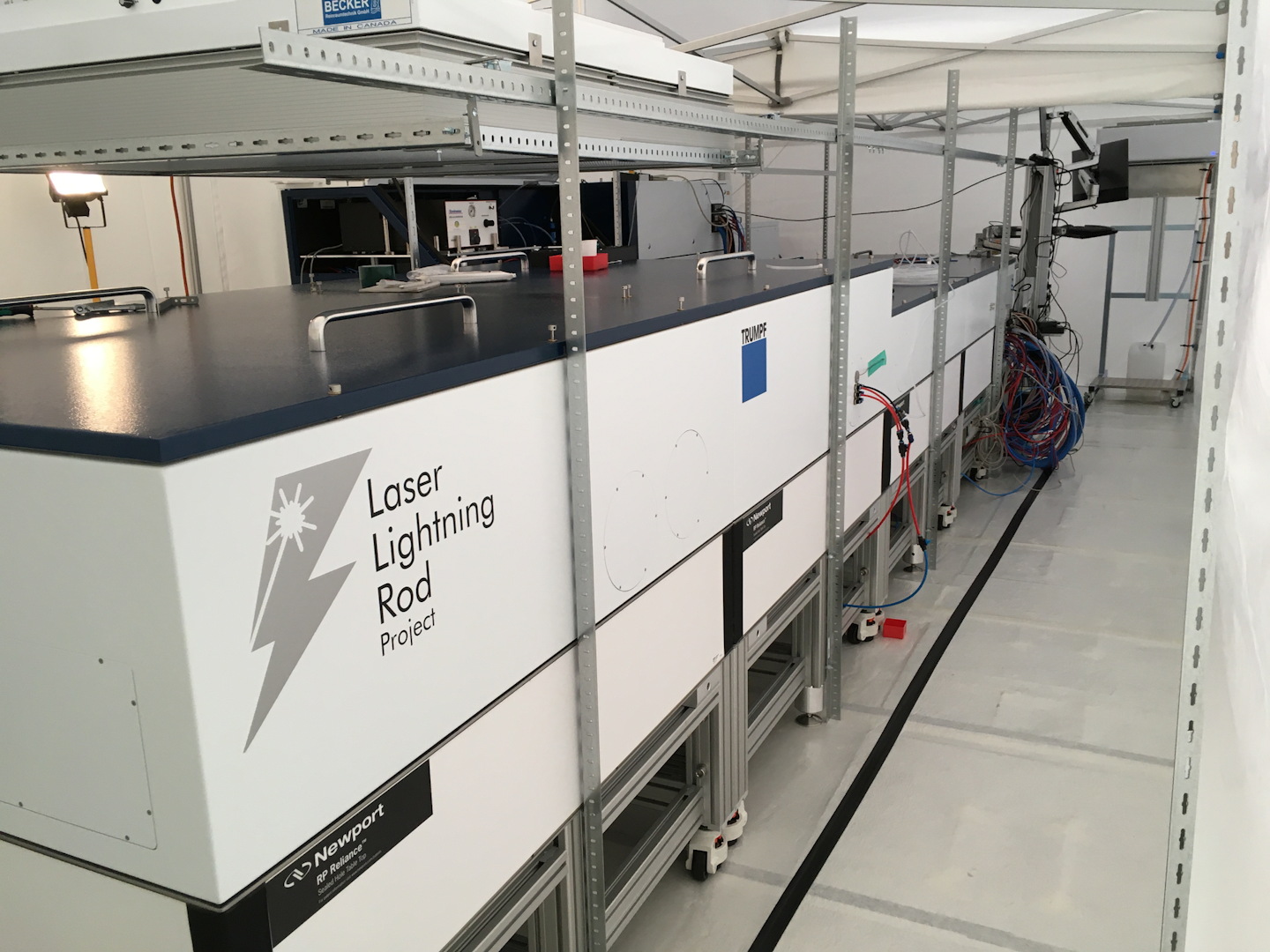
Clearing the sky
Laser lightning research has been funded for more than 25 years. In Europe, there were grants from German, French, and European research organizations, and in America it was a Department of Defense grant. Within the new Laser Lightning Rod project, there are seven participants, including Airbus and the space company ArianeGroup. That points to expectations from the aerospace industry. As a rule of thumb, a lightning rod can protect an area with a diameter of its height. So, a laser lightning rod 1000 m high could protect a rocket launch site or the approach path of an airport, one might think. But Wolf thinks further: “Ground to satellite laser communication is of increasing importance. We would try to open them a clear optical channel in a cloud.” It remains an old dream to control a lightning bolt. Now watch the Swiss sky for a very straight flash this summer. If you see it, well, then it has happened.
spacer
Thunderstorms and lightning create nuclear reactions and radiation say scientists
‘I think there is no health risk from this phenomena‘
“Several groups have accumulated signatures of this [phenomenon], such as signals of either neutrons or positrons, which are the products of this reaction.”
Scientists have used observatories and satellites to detect these neutrons, positrons and other particles since the 1980s, but until now it was difficult to confirm they were the product of nuclear reactions.
In pictures: Lightning in the UK
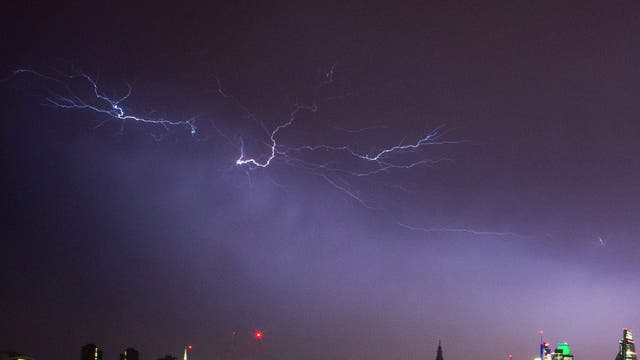
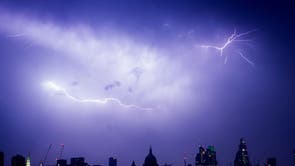
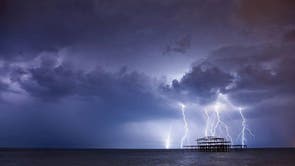
During a thunderstorm in February this year, Professor Enoto and his team detected “intense radiation” from a pair of lightning strikes just off the coast, using equiupment installed at the Kashiwazaki-Kariwa nuclear power station in Niigata.
It was followed by a prolonged gamma-ray line with the same energy signature scientists would expect to see from the positrons and electrons following a nuclear reaction.
And at the very least, it proves that there’s more going on in thunderstorms than scientists originally thought.|
spacer
Study Finds Lightning Helps Cleanse Atmosphere | AccuWeather
Hydroxyl radicals, described as a “chemical scavenger” by Science Direct, are important chemical compounds found in the atmosphere due to the reactive nature with other organic molecules.
Researchers previously understood that lightning could help to clean the atmosphere, but there was not evidence that it could generate compounds like these radicals. And the data showed surprising spikes of up to 1,000 more hydroxyl radicals than the normal value.
“No one has seen that much in the atmosphere from natural processes, ever,” Brune said.
As a result, the study estimates that somewhere between 2% and 16% of the oxidizing, or cleaning that happens naturally in the Earth’s atmosphere, is done by lightning.
Why is this significant? The oxidation process helps to reduce chemicals like carbon monoxide and methane in the atmosphere. These chemicals, known for being greenhouse gases, have been proven to contribute to rising temperatures associated with climate change.
TO READ MORE:Lightning and subvisible discharges produce molecules that clean the atmosphere
spacer
What is Dark Lightning? | IFLScience
Lightning occurs as a result of charge separation in a cloud. When negatively charged electrons build up at the base of a thundercloud, anything it passes over will become positively charged. If the cloud passes over a tall object, like a skyscraper, the electrons will make the jump, creating the pitchfork of light you see streaking across the sky.
Scientists have realized though that the process of creating regular lightning produces sprays of x-rays and gamma rays that are also ejected into the atmosphere. This is what scientists are now calling dark lightning. Though we can’t see dark lightning, it produces some very measurable cascade effects.
To hear more about dark lightning, view NASA’s video about it below:
What causes lightning and thunder? | NOAA SciJinks
Lightning!
Zap! You just touched a metal doorknob after shuffling your rubber-soled feet across the carpet. Yipes! You’ve been struck by lightning! Well, not really, but it’s the same idea.
Your rubber-soled shoes picked up stray electrons from the carpet. Those electrons built up on your shoes giving them a static charge. (Static means not moving.) Static charges are always “looking” for the first opportunity to “escape,” or discharge. Your contact with a metal doorknob—or car handle or anything that conducts electricity—presents that opportunity and the excess electrons jump at the chance.
What causes lightning?
So, do thunderclouds have rubber shoes? Not exactly, but there is a lot of shuffling going on inside the cloud.

Credit: John Jensenius
It’s a little more complicated than that, but what results is a cloud with a negatively charged bottom and a positively charged top. These electrical fields become incredibly strong, with the atmosphere acting as an insulator between them in the cloud.
When the strength of the charge overpowers the insulating properties of the atmosphere, Z-Z-Z-ZAP! Lightning happens.
How does the lightning “know” where to discharge—or strike?
The electric field “looks” for a doorknob. Sort of. It looks for the closest and easiest path to release its charge. Often lightning occurs between clouds or inside a cloud.
But the lightning we usually care about most is the lightning that goes from clouds to ground—because that’s us!
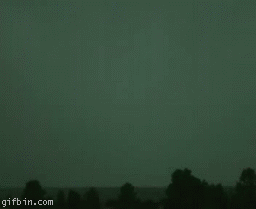
As the storm moves over the ground, the strong negative charge in the cloud attracts positive charges in the ground. These positive charges move up into the tallest objects like trees, telephone poles, and houses. A “stepped leader” of negative charge descends from the cloud seeking out a path toward the ground. Although this phase of a lightning strike is too rapid for human eyes, this slow-motion video shows it happening.
As the negative charge gets close to the ground, a positive charge, called a streamer, reaches up to meet the negative charge. The channels connect and we see the lightning stroke. We may see several strokes using the same path, giving the lightning bolt a flickering appearance, before the electrical discharge is complete.
Click for larger animated image
What causes thunder?
In a fraction of a second, lightning heats the air around it to incredible temperatures—as hot as 54,000 °F (30,000 °C). That’s five times hotter than the surface of the Sun!
The heated air expands explosively, creating a shockwave as the surrounding air is rapidly compressed. The air then contracts rapidly as it cools. This creates an initial CRACK sound, followed by rumbles as the column of air continues to vibrate.
If we are watching the sky, we see the lightning before we hear the thunder. That is because light travels much faster than sound waves. We can estimate the distance of the lightning by counting how many seconds it takes until we hear the thunder. It takes approximately 5 seconds for the sound to travel 1 mile. If the thunder follows the lightning almost instantly, you know the lightning is too close for comfort!
What does lightning look like from space?
First Images from GOES-16 Lightning Mapper
Lightning observed by the GOES-16 Geostationary Lightning Mapper (GLM) illuminates the storms developing over southeast Texas on the morning of February 14, 2017.
Lightning is an important part of weather forecasting. The Geostationary Lightning Mapper instrument on the GOES-R series satellites can detect lightning activity over nearly the whole Western Hemisphere.
Scientists use data from GOES-R series satellites, along with data from the Lightning Imaging Sensor on NASA’s Tropical Rainfall Measuring Mission satellite, to study lightning. This complete picture of lightning at any given time will improve “now-casting” of dangerous thunderstorms, tornadoes, hail, and flash floods.
spacer
UNIVERSE TODAY
Navy Researchers Put Dark Lightning to the SWORD …
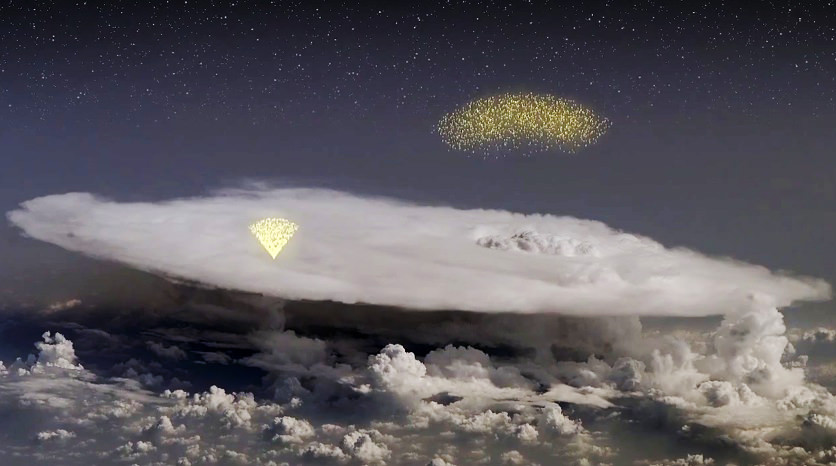
Navy Researchers Put Dark Lightning to the SWORD
Discovered “by accident” by NASA’s Fermi Gamma-ray Space Telescope in 2010, dark lightning is a surprisingly powerful — yet invisible — by-product of thunderstorms in Earth’s atmosphere. Like regular lightning, dark lightning is the result of a natural process of charged particles within storm clouds trying to cancel out opposing charges. Unlike normal lightning, though, dark lightning is invisible to our eyes and doesn’t radiate heat or light — instead, it releases bursts of gamma radiation.
What’s more, these gamma-ray outbursts originate at relatively low altitudes well within the storm clouds themselves. This means that airplane pilots and passengers flying through thunderstorms may be getting exposed to gamma rays from dark lightning, which are energetic enough to pass through the hull of an aircraft… as well as anything or anyone inside it. To find out how such exposure to dark lightning could affect air travelers, the U.S. Naval Research Laboratory (NRL) is conducting computer modeling tests using their SoftWare for the Optimization of Radiation Detectors — SWORD, for short.
Terrestrial Gamma-ray Flashes (TGFs) are extremely intense, sub-millisecond bursts of gamma rays and particle beams of matter and anti-matter. First identified in 1994, they are associated with strong thunderstorms and lightning, although scientists do not fully understand the details of the relationship to lightning. The latest theoretical models of TGFs suggest that the particle accelerator that creates the gamma rays is located deep within the atmosphere, at altitudes between six and ten miles, inside thunderclouds and within reach of civilian and military aircraft.
These models also suggest that the particle beams are intense enough to distort and collapse the electric field within thunderstorms and may, therefore, play an important role in regulating the production of visible lightning. Unlike visible lightning, TGF beams are sufficiently broad — perhaps about half a mile wide at the top of the thunderstorm — that they do not create a hot plasma channel and optical flash; hence the name, “dark lightning.”
A team of NRL Space Science Division researchers, led by Dr. J. Eric Grove of the High Energy Space Environment (HESE) Branch, is studying the radiation environment in the vicinity of thunderstorms and dark lightning flashes. Using the Calorimeter built by NRL on NASA’s Fermi Gamma-ray Space Telescope they are measuring the energy content of dark lightning and, for the first time, using gamma rays to geolocate the flashes.
As a next step, Dr. Chul Gwon of the HESE Branch is using NRL’s SoftWare for the Optimization of Radiation Detectors (SWORD) to create the first-ever simulations of a dark lightning flash striking a Boeing 737. He can calculate the radiation dosage to the passengers and crew from these Monte Carlo simulations. Previous estimates have indicated it could be as high as the equivalent of hundreds of chest X-rays, depending on the intensity of the flash and the distance to the source.

(Credit: U.S. Naval Research Laboratory)
SWORD simulations allow researchers to study in detail the effects of variation in intensity, spectrum, and geometry of the flash. Dr. Grover’s team is now assembling detectors that will be flown on balloons and specialized aircraft into thunderstorms to measure the gamma ray flux in situ. The first balloon flights are scheduled to take place this summer.
Source: NRL News
spacer
Lightning primarily occurs when warm air is mixed with colder air masses, resulting in atmospheric disturbances necessary for polarizing the atmosphere. However, it can also occur during dust storms, forest fires, tornadoes, volcanic eruptions, and even in the cold of winter, where the lightning is known as thundersnow. Hurricanes typically generate some lightning, mainly in the rainbands as much as 160 kilometres (99 mi) from the center.
The science of lightning is called fulminology, and the fear of lightning is called astraphobia.
(Interesting that fear of Lightning is called “astraphobia” Astra means of or related to the stars. The stars is also a reference to fallen angels, which is also a reference to the “ancient gods”)
astral (adj.) from etymology online
spacer

Picatinny engineers set phasers to ‘fry’
By Jason Kaneshiro, AMC June 22, 2012With
PICATINNY ARSENAL, N.J. (June 21, 2012) — Scientists and engineers at Picatinny Arsenal are busy developing a device that will shoot lightning bolts down laser beams to destroy its target. Soldiers and science fiction fans, you’re welcome.
“We never got tired of the lightning bolts zapping our simulated (targets),” said George Fischer, lead scientist on the project.
The Laser-Induced Plasma Channel, or LIPC, is designed to take out targets that conduct electricity better than the air or ground that surrounds them. How did the scientists harness the seemingly random path made by lightning bolts and how does a laser help? To understand how the technology, it helps to get a brief background on physics.
“Light travels more slowly in gases and solids than it does in a vacuum,” explained Fischer. “We typically think of the speed of light in each material as constant. There is, however, a very small additional intensity-dependent factor to its speed. In air, this factor is positive, so light slows down by a tiny fraction when the light is more intense.”
“If a laser puts out a pulse with modest energy, but the time is incredibly tiny, the power can be huge,” Fischer continued. “During the duration of the laser pulse, it can be putting out more power than a large city needs, but the pulse only lasts for two-trillionths of a second.”
Why is this important?
“For very powerful and high intensity laser pulses, the air can act like a lens, keeping the light in a small-diameter filament,” said Fischer. “We use an ultra-short-pulse laser of modest energy to make a laser beam so intense that it focuses on itself in air and stays focused in a filament.”
To put the energy output in perspective, a big filament light bulb uses 100 watts. The optical amplifier output is 50 billion watts of optical power, Fischer said.
“If a laser beam is intense enough, its electro-magnetic field is strong enough to rip electrons off of air molecules, creating plasma,” said Fischer. “This plasma is located along the path of the laser beam, so we can direct it wherever we want by moving a mirror.”
“Air is composed of neutral molecules and is an insulator,” Fischer said. When lightning from a thunderstorm leaps from cloud to ground, it behaves just as any other sources of electrical energy and follows the path of least resistance.
“The plasma channel conducts electricity way better than un-ionized air, so if we set up the laser so that the filament comes near a high voltage source, the electrical energy will travel down the filament,” Fischer elaborated.
A target, an enemy vehicle or even some types of unexploded ordnance, would be a better conductor than the ground it sits on. Since the voltage drop across the target would be the same as the voltage drop across the same distance of ground, current flows through the target. In the case of unexploded ordnance, it would detonate, explained Fischer.
Even though the physics behind the project is sound, the technical challenges were many, Fischer recalled.
“If the light focuses in air, there is certainly the danger that it will focus in a glass lens, or in other parts of the laser amplifier system, destroying it,” Fischer said. “We needed to lower the intensity in the optical amplifier and keep it low until we wanted the light to self-focus in air.
Other challenges included synchronizing the laser with the high voltage, ruggedizing the device to survive under the extreme environmental conditions of an operational environment, and powering the system for extended periods of time.
“There are a number of high-tech components that need to run continuously,” said Fischer.
But despite the challenges, the project has made notable progress in recent months.
“Definitely our last week of testing in January 2012 was a highlight,” said Tom Shadis, project officer on the program. “We had a well thought-out test plan and our ARDEC and contractor team worked together tirelessly and efficiently over long hours to work through the entire plan.
“The excellent results certainly added to the excitement and camaraderie,” added Fischer.
As development continues, Shadis said that those involved with the project never lose sight of the importance of their work.
“We were all proud to be serving our warfighters and can picture the LIPC system saving U.S. lives,” Fischer said.
Related Links:
spacer
FEAR OF LIGHTNING
Making Electromagnetic Weapons: Directed Microwave Energy …
I’m sure almost all of you have used a microwave at some point in your lives. As a child, I always found microwaves fascinating; the idea of heating food with invisible energy, and even creating lightning should the user accidentally microwave metal! However, microwaves are not only used for heating food. Microwave energy generally falls under the 2.4 GHz (Gigahertz band). This same band is used by many wireless technologies such as Bluetooth and Wi-Fi. Microwaves consist of any wavelength between 300 MHz (0.3 GHz) and 300 GHz. The range (energy) depends on the “strength” of the wavelength.
Here’s a visual representation of the electromagnetic spectrum:
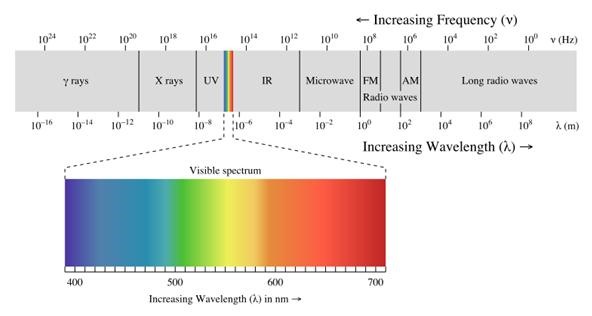
Simple Cooking Appliance or Lethal Weapon?
Well, it really depends. In this article, I’ll be going over the simple basics of a microwave weapon, since microwave energy is a huge topic. In its simplest form, any waveform transfer of energy starts with excited particles and ends with excited particles.
Inside a microwave, you’ll find a large transformer (called a MOT or Microwave Oven Transformer), a large capacitor (rated around 1-2 kV; 1-100 uF), some high voltage diodes (for rectifying the alternating current from the transformer), a magnetron (the microwave emitter—I’ll go into this later), and other electrical components for operating the main electronics.
In a Microwave Weapon (MW), the components can be as simple as a magnetron, a transformer, a diode, and a capacitor. Of course, the magnetron is certainly not that simple, consisting of several finely tuned “antennas” and other components. A basic illustration of how a magnetron works is pictured below:

The round “1” is an electron source, the area between the power source and the antenna is the electron “accelerator”, and the antenna itself is a simple way of “amplifying” and broadcasting the electron energy at a specific frequency. When these “tuned electrons” hit an object (specifically water or metal), they excite the molecules and generate heat, or in the case of metal, electrical energy. This is why microwaves are so dangerous compared to EMPs. Microwaves not only wreck havoc on electronics, but also can harm living beings.
This is where I must issue a WARNING!!! Microwaves are extremely dangerous. They can PERMANENTLY HARM YOU! If you feel even the slightest uncertainty towards the physics, dangers, and overall understanding of microwaves, DO NOT construct a microwave weapon.
The Construction
The best way to create a homemade microwave weapon is with an old microwave. If you want to upgrade to a more powerful, long range device, it’s practically impossible unless you have a physics lab with extensive measuring equipment. However, an average microwave puts out 1,000-2,000 watts of energy, quite enough for destroying electronics.
 Microwaves tend to “fly in all directions” unless they are directed. However, this is what the antenna does—directs the microwaves. In my experimentation, I discovered that a slight cone-shaped metal funnel has the best microwave-focusing ability. I was able to fry an old cell phone from up to 10 feet using three magnetrons and one funnel. This constitutes to about 6,000 watts (W) of directed energy, quite an accomplishment for 15 bucks spent at a thrift store. The circuit diagram for each individual magnetron looked something like this:
Microwaves tend to “fly in all directions” unless they are directed. However, this is what the antenna does—directs the microwaves. In my experimentation, I discovered that a slight cone-shaped metal funnel has the best microwave-focusing ability. I was able to fry an old cell phone from up to 10 feet using three magnetrons and one funnel. This constitutes to about 6,000 watts (W) of directed energy, quite an accomplishment for 15 bucks spent at a thrift store. The circuit diagram for each individual magnetron looked something like this:
 On a basic level, the circuit consists of a transformer, a voltage doubler (diode and capacitor) and a magnetron. The three MOTs draw lots of power, so I had to hook everything into a thick, direct mains line. The magnetron itself looks like this:
On a basic level, the circuit consists of a transformer, a voltage doubler (diode and capacitor) and a magnetron. The three MOTs draw lots of power, so I had to hook everything into a thick, direct mains line. The magnetron itself looks like this:
There are two large magnets that “direct” the electrons as they pass through the antenna. Also, the device has a heat sink to cool off. There are many other components and function aspects of the magnetron that are very complicated, but interesting. If you’re curious, check out the information in this article.
Once finished, the entire apparatus should look something like this:

The waveguide (or metal funnel cone) guides the microwaves in a linear direction, and allows them to be focused in a specific direction. Once directed, the microwaves can generate electrical current in any conductive metal they encounter. How much electricity they generate is determined by the distance from the magnetron and the power of the output. The microwave gun will also disrupt wireless communications (depending on their frequencies) and excite water molecules.
- MICROWAVES ARE VERY VERY DANGEROUS. DO NOT attempt to build this device unless you are very very confident in your understanding of the dangers, correct practice of safety, and legal concerns.
- HIGH VOLTAGE! Microwave Transformers can easily kill you! Treat then with respect! Remember… Fear of Lightning.
- DO NOT use this device on anything or anywhere where it violates FCC rules or any other legal constraint!
- I am not responsible for any damage, harm, or legal trouble you get yourself into.
Home of the Giza Community and Dr. Joseph P. Farrell

Yea, I know all this sounds nutty, and it probably is.
But the nuttiness isn’t mine. It belongs to “them”, you know, the guys that sit around and dream all this stuff up. “N.” found this article and passed it along (our thanks!), and it’s worth absorbing, because it’s not coming from an “alternative media” source, but from Forbes magazine:
spacer
When The CIA Considered Weaponizing Lightning
Here’s what has leaped out at me:
Thunderbolts are traditionally the weapon of the gods, but in 1967 the CIA were wondering whether they, too, could call down bolts of lightning from the heavens at will.
The idea is contained in a proposal from a scientist, sent to the CIA’s Deputy for Research ‘Special Activities’ and passed on to the chief of the Air Systems division. The scientist’s name has been redacted in the declassified document from the CIA’s archive, but the proposal mentions a previous discussion with the CIA, indicating they were being taken seriously.
The guided lightning concept is based on the observation that lightning follows a path of ionized air known as a step leader. Once the leader stroke reaches the ground and makes a circuit, the lightning proper is formed and a current flow, typically around 300 million Volts at 30,000 Amps.
The scientist suggests that artificial leaders could “cause discharges to occur when and where we want them.” The artificial leader would be a wire a few thousandths of an inch in diameter and several miles long. Wires would be inserted into storms by aircraft or rockets on a spool, and unrolled by a drogue parachute, and lightning would follow them down to the ground.
“This method is possible because the main discharge will occur through ionized surrounding the wire,” notes the scientist. The wire, like the leader, is only needed to get the lightning going, and would still work even if it broke.
Now let’s dive into today’s high octane speculation. If you’ve been following the phenomenon of “chemtrails” and the spraying being conducted, one of the things you’ll have come across is the claim that much of the material being sprayed is particulate heavy metals. Sometimes the composition of this spray varies, but among the metals most often mentioned in this regard are aluminum, and barium. Sometimes there are others. In some examinations, the spraying began during the Reagan era as a secretive effort to increase the electrical conductivity of the atmosphere for his Strategic Defense Initiative project. This needed a “cover story,” so in some versions, the spraying was being done to “save the environment” or to “combat climate change” (which explanation in itself is intriguing, because that implied the ability to manipulate weather on a planetary scale).
As the article itself notes, the use of wires was intended to provide a channel for lightning to close the circuit between the atmosphere and the ground, but that it “would still work even if it broke.” In other words, you do not need a long wire, but several short ones in close proximity to each other to provide a channel or circuit for the lightning. Like particulate aerosolized heavy metals…
The next thing one needs is the ability to create the large charge differentials to be able to cause lightning to strike, otherwise that sheath of heavy metals might function to block such strikes like a big Faraday cage, though in my opinion this possibility is unlikely for a variety of reasons. In any case, one needs an ability to ionize the atmosphere sufficiently to build up these enormous charges, or to take a naturally occurring storm, and load more energy into it. Enter the ionosphere heaters like HAARP. Indeed, when this technology was being dreamed up and patented – incidentally, during Reagan’s Strategic Defense Initiative era – some of the uses claimed for it were weather modification and steering, missile defense, and some analysts also made good cases that it could be used to cause lightning strikes.
In other words, the USA had, and has had, this capability since at least the 1980s, and probably now many other nations as well. Put the two together – the spraying and the heaters – and one would have the equivalent, perhaps, of the ability to bombard a region or area with lightning, a kind of “carpet bombing with lightning”, and to coin a pun, a true and proper Blitz.
Obviously, carpet bombing with lightning isn’t exactly “assassination” in any classical sense. For that, one would need some means for precision strikes, not just an aerosolized region and lightning strikes to start forest fires. One would need some means to be able to dial someone up, or at least, locate them, and use whatever such device that might be providing that location, to pulse it and them.
Yea… I know. It sounds nutty. And probably is.
But… while you’re reading this on your ipad, remember that the first two essential requirements have been around since the 1980s at least, and the weaponized lightning idea since at least 1967, if not long before that, with the lightning bolts of the gods, who may not have been gods at all, but just people with an extraordinarily sophisticated science. After all, the ability to call down lightning strikes at a specific point would certainly impress a bunch of hairless monkeys who were still using bows and arrows to accomplish their mischief.
See you on the flip side…
spacer
![]()
Lightning laser weapon developed by US Army
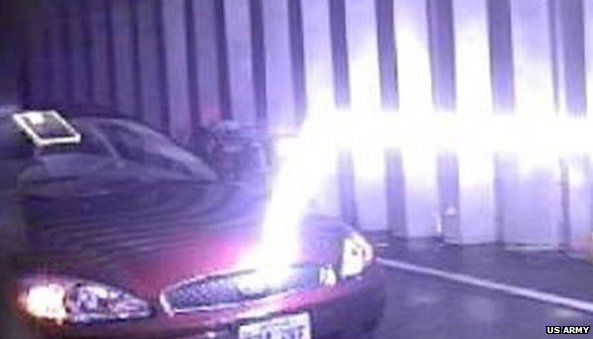
US Army scientists are developing a weapon which can fire a laser-guided lightning bolt at a target.
The Laser-Induced Plasma Channel (LIPC) is designed to hit targets that conduct electricity better than the air or ground that surrounds them.
The weapon went through extensive testing in January (2012).
George Fischer, lead scientist on the project, said: “We never got tired of the lightning bolts zapping our simulated [targets].”
Details of the weapon were released on the US Army’s website.
Mr Fischer explained how the usually unpredictable lightning bolts can be controlled.
“During the duration of the laser pulse, it can be putting out more power than a large city needs, but the pulse only lasts for two-trillionths of a second.”
50 billion watts
This means, Mr Fischer said, the air could be manipulated to “act like a lens”.
“We use an ultra-short-pulse laser of modest energy to make a laser beam so intense that it focuses on itself in air and stays focused in a filament,” he said.
Fifty billion watts of optical power are used. By comparison, a typical filament lightbulb uses 100 watts of power.
“If a laser beam is intense enough, its electro-magnetic field is strong enough to rip electrons off of air molecules, creating plasma,” Mr Fischer said.
The team said it faced a challenge in making the technology rugged enough to survive in harsh battle conditions.
The military’s scientific fringe has toyed with weather manipulation and geo-engineering for years. Recently, ideas like adding iron to the ocean, or covering the Arctic with dust, have been floated in a bid stave off global warming. But the Pentagon’s also got a long track record of plotting to screw with enemy climates and improve their own operational abilities.
Now, Darpa’s got a new target for geo-hacking science, and if they can make it work, we might see modern firearms making way for weapons of the mythological variety. The out-there research agency is soliciting proposals that would harness control over “the natural mechanism of lightning initiation“ by coming up with a way to launch manmade lightning bolts, and prevent or redirect natural lightning strikes — and their accompanying destruction.
Once the natural mechanism of lightning formation and travel is understood, the agency wants a plan to predict lightning strikes — and then either stop the storms, or reroute them to a better strategic location.
And Americans everywhere should brace themselves for stormy skies, because Darpa wants the storm-brewing techniques to be tested nationwide:
[Photo: Lawrence Livermore National Lab]
ALSO:
- Navy Research Paper: ‘Disrupt Economies’ with Man-Made ‘Floods …
- Video: China’s Weather Control Brigade
- Gallery: Inside Alaska’s Answer to Area 51
- Scientist Looks to Weaponize Ball Lightning
- Lightning Gunners Take to the Skies
spacer

Interesting report I found 1994 Air Force report on the biological effects of Radio Frequency Microwaves, NEXRAD pulsing microwaved 24/7 in the United States and Fire + Microwaves = Plasma
https://apps.dtic.mil/dtic/tr/fulltext/u2/a282886.pdf
https://www.unr.edu/nevada-today/news/2018/carr-firenado
https://www.roc.noaa.gov/WSR88D/Maps.aspx
http://tempest.aos.wisc.edu/radar/uscompflash.html
To Watch This Video on BitCHUTE: CLICK HERE

spacer
 Geoengineering Watch Global Alert News, July 3, 2021, #308
Geoengineering Watch Global Alert News, July 3, 2021, #308
GeoengineeringWatch.org
Sat, Jul 3, 4:49 PM (8 hours ago)
The climate engineers have yet again set the stage for record incinerations in western North America, the burning has begun. The increasingly shocking CV-19 vaccination reaction, injury, and mortality statistics are being systematically censored by all major media sources. The walls are closing in by the day and even now few are willing to face the gravity and immediacy of what is unfolding. Thank you for tuning in to this weeks installment of Global Alert News, thank you also for your help with sounding the alarm.
Most sincerely,
Dane

Full article: https://www.
Geoengineering Watch Global Alert News, July 3, 2021, #308 – ( Dane Wigington )
All are needed in the critical battle to wake populations to what is coming, we must make every day count. Share credible data from a credible source, make your voice heard. Awareness raising efforts can be carried out from your own home computer.Dane Wigington
GeoengineeringWatch.org

TO WATCH THIS VIDEO ON BITCHUTE: CLICK HERE
GEOENGINEERING WATCH GLOBAL ALERT NEWS, JULY 3, 2021, #308 ( DANE WIGINGTON )
If you like this video, please SUBSCRIBE to our channel: https://www.youtube.com/c/DaneWigington Click the bell to ensure you are notified of our new videos.
Record heat, fires, smoke, hurricanes, floods and huge hail, how’s is your 4th of July holiday going? Western North America is yet again being baked and burned to the ground, and summer is just getting started. The eastern half of the US continues to be kept cool and wet in between heat waves. Covert climate intervention operations are core to both equations. Within the ranks of populations, many continue to blindly roll up their sleeves in the belief that doing so will somehow save them from what is unfolding. How long do we have until impact?
All are needed in the critical battle to wake populations to what is coming, we must make every day count. Share credible data from a credible source, make your voice heard. Awareness raising efforts can be carried out from your own home computer.
Dane Wigington
For more information go to the full Geoengineering Watch article: https://www.geoengineeringwatch.org/geoengineering-watch-global-alert-news-july-3-2021-308/
To support Geoengineering Watch: http://www.geoengineeringwatch.org/support/
To receive Geoengineering Watch updates, please sign up for our mailing list: https://www.geoengineeringwatch.org/newsletter/
Must view, THE DIMMING, the most comprehensive climate engineering documentary: https://youtu.be/rf78rEAJvhY
The Catastrophic Consequences Of Climate Engineering: https://youtu.be/kyxmrwbTKoM
To see firsthand film footage of the climate engineering impact on our forests and its vanishing inhabitants, view the new series: “Into The Wild, With Dane Wigington”: https://www.youtube.com/playlist?list=PLwfFtDFZDpwvtAJ2yrKO3idEKDP3miLq9
In the attempt to answer as many questions as possible on the dire issue of climate engineering, Geoengineering Watch is producing a weekly “Climate Engineering News Q and A”: https://www.geoengineeringwatch.org/climate-engineering-news-q-a/
By submitting a question to this email questions@geoengineeringwatch.org you are granting permission for your question and your first name to be read online. If you do not want your first name mentioned, please state that you wish to remain anonymous.
Geoengineering Watch has conducted our first ever high altitude particulate testing. Film footage of the flight and lab testing processes are featured in “The Dimming”, a groundbreaking documentary. This is a 12+ minute insight segment of the film: https://youtu.be/4x3z35HA6JQ

spacer
Must view, THE DIMMING, the most comprehensive climate engineering documentary:
spacer
It might help you to understand and accept that this is all true, if you understand the WHY… the motivation of these folks. Here it is. THEY WANT TO BE GOD.
spacer
The following clip presents a quote from Richard Seed, Physical Human Cloning Researcher:
“We are going to become GODs, period”

“We are going to become Gods period. If you don’t like it, get off. But, if you are going to interfere with me becoming God, we’re gonna have big trouble. We will have warfare. The only way you can prevent me in this is to kill me, you kill me, I will kill you. God made man in his own image. God intended for man to become one with God. We are going to become one with God. Cloning and the reprogramming of DNA is the first serious step, in becoming one with God.” Richard Seed Source: Wikipedia
 This is the oldest lie ever told. Satan has not had to change his strategy at all! Man’s ego is so strong, he is eager to believe the lie. Satan is a created being. He is foolish enough to assume that he is smarter than the Creator. Satan could not even save himself from eternal damnation.
This is the oldest lie ever told. Satan has not had to change his strategy at all! Man’s ego is so strong, he is eager to believe the lie. Satan is a created being. He is foolish enough to assume that he is smarter than the Creator. Satan could not even save himself from eternal damnation.
Type 1 through 7 Civilizations
In 1964 a Soviet astronomer by the name of Nikolai Kardashev introduced a hypothetical scale that can be used to measure the potential of a civilization based on the amount of energy it can produce. There have been some adjustments to the kardeshev scale over the years, and now it shows the amount of energy required for the types of civilizations and what they are capable of.
The mathematics shows that there should be thousands of types 1, 2, and 3 civilizations, but we just don’t see any. This could be because the transition from type 0 to type 1 is so dangerous. To realize how dangerous it can be, I need to explain what type 0 and type 1 civilizations are.
Type 0 civilization is any civilization that is not capable of harnessing all the energy from its home planet. We are about a .7 because we do collect some energy from the sun, water, and air, but that is not the main source of energy. We choose energy that isn’t renewable and it will one day run out.
Type 1 civilization can gather all the energy that reaches the home planet in the form of solar but it can also obtain the energy its home planet gives off, like thermal, wind, hydro, etc. Physicist Michio Kaku thinks a planetary civilization should be able to control such things as earthquakes, the weather, volcanoes, and would be building ocean cities. If that’s the case, we are not quite there yet. Kaku thinks it’ll take another 100–200 or so years for us to get to Type 1 status. Carl Sagan thought we are currently at about 0.7 on the way to type 1. Type 1 civilization has peace throughout the entire planet, and they also have a universal language.
Michio Kaku 3 types of Civilizations – YouTube
A Type-1 civilization has harnessed its planetary power. They control earthquakes, the weather, volcanoes, they have cities on the ocean, anything planetary – they control. That’s Type-1 civilization.
A Type-2 civilization is stellar. They have exhausted the power of the planet, and they get their energy directly from their mother star. They use the power of the sun itself to energize their huge machines.
Will Humans Achieve a Type 1 Civilization by 2100?
Now what are we on this scale? We are Type-0. We don’t even rate on this scale. We get our energy from not stars and galaxies, but from dead plants – Oil and coal. But we can calculate when we will attain Type-1 status – In about a hundred years!
We are seeing the beginnings of a Type-1 economy. Huge planetary trading blocks are the beginnings of a planetary economy (Referring to European Union, NAFTA, etc). And what is the Internet? The Internet is the beginning of a Type-1 telephone/communications system.
The mathematics says that there should be thousands of Type-1, 2 and 3 civilizations in the galaxy. But we see no evidence of it anywhere. And why is that? Because, the transition from Type-0 to Type-1 is the most dangerous of all transitions. We may not make it. Its a race against time.
There is a question that is beginning to haunt the world of science; it’s been rearing its ugly head for the last several decades. The question is simply, “is the universe unnatural?”
As most of you are aware, particle physicists at the Large Hadron Collider (LHC) announced in July of 2012 that they had finally discovered the elusive Higgs boson – that discovery has since been confirmed. The confirmation of the Higgs’ existence was one of the greatest triumphs of science in 2012, confirming the nearly 50-year-old theory that aims to explain how elementary particles have mass. Arkani-Hamed from the Institute for Advanced Study explained, “the fact that it was seen more or less where we expected to find it is a triumph for the experiment, it’s a triumph for the theory, and it’s an indication that physics works.”
This discovery, however, was a double edged sword.
The Higgs has gotten all of the media attention; however, quantum theories also suggest that scientists should have found a host of other particles along with the Higgs in order to really show that the whole theory makes sense. Thus far, these particles haven’t been found. That might not sound like a big deal, but without these accompanying particles, using our current understandings of quantum theory, the Higgs’ mass in reality is exponentially different than what is predicted by the modified theories.
 ️
️

![Lightning_hits_tree[1]](http://wattsupwiththat.files.wordpress.com/2014/05/lightning_hits_tree1.jpg?w=114&resize=114%2C150)
:max_bytes(150000):strip_icc():format(webp)/melissa-breyer-bw-00315c82232e4f75832ad74875733cd6.jpg)



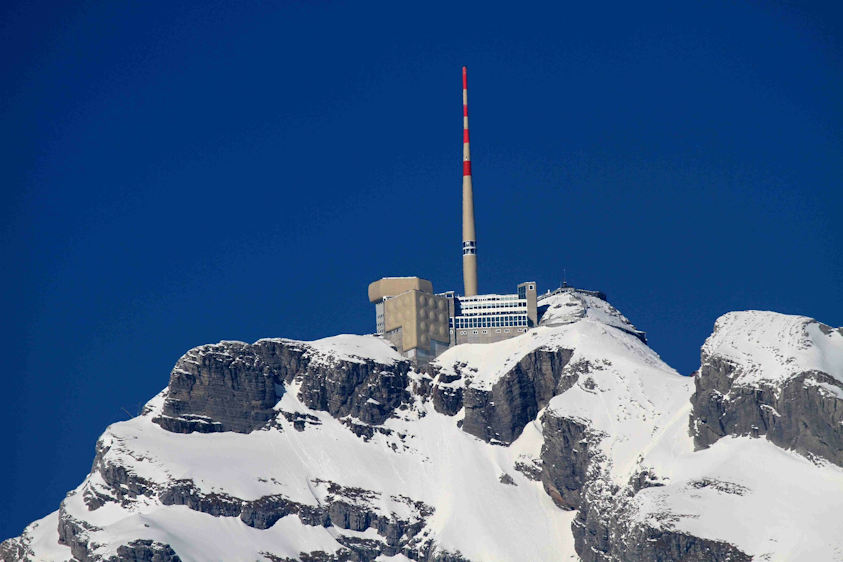
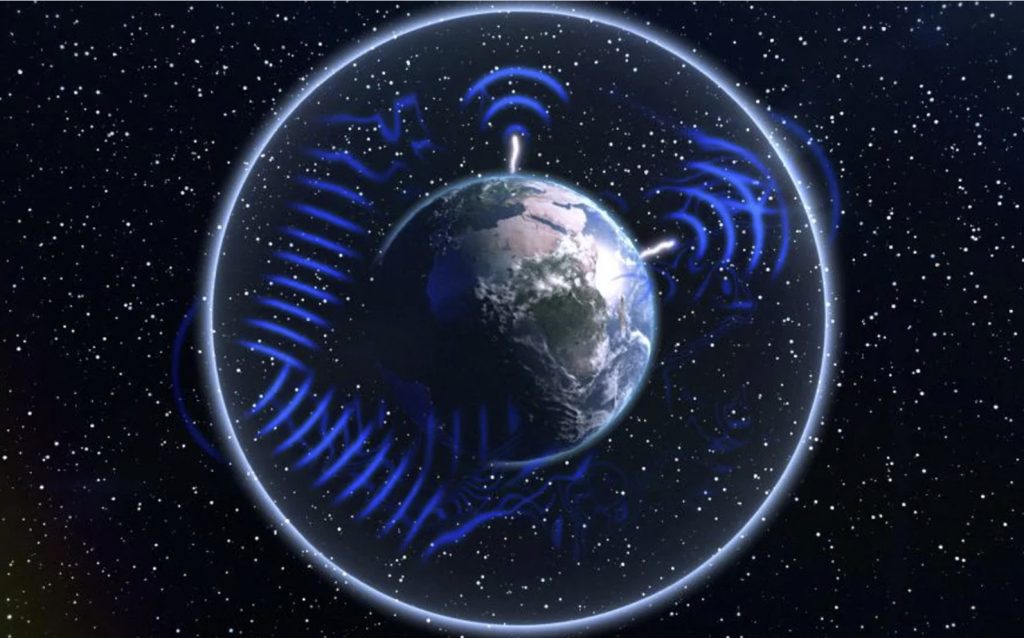
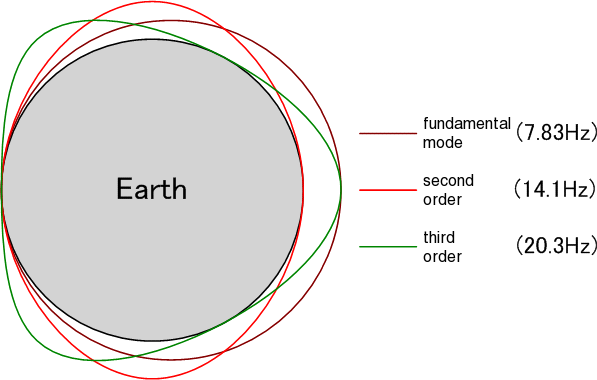
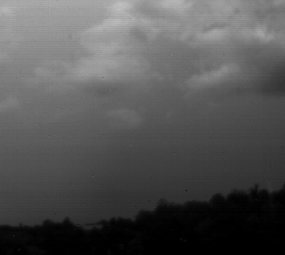
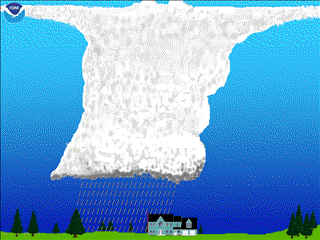







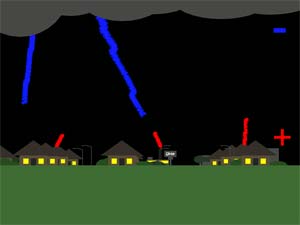






The strange properties of water zapped by lightning
Dec 14, 2015 / Lucas Laursen (PAW = Plasma activated Water)
Why an environmental chemist in Holland is betting that both farming and hospitals might be improved with the use of a fancy form of water.
Something funny happens to water when you spray it through an electrical field: The water can now fight microbes. (Or something in the water can.) Plasma-activated water (PAW) is a fascinating substance that scientists around the world are looking at, in a fast-developing field that’s testing a broad range of uses. Dutch environmental chemist Paul Leenders (TEDxArnhem talk: Plasma-activated water: Nature’s answer to chemical pesticides) hopes to harness PAW to fight microbes in hospitals and on farms. Here’s how it works.
Plasma-activated water: less exotic than it sounds. After solid, liquid and gas comes plasma, the fourth state of matter. Lightning is one of Nature’s ways of making plasma, and scientists can replicate it in the lab by running electricity through a pair of electrodes; the strong electrical field ionizes air molecules and turns them into plasma. Scientists have been experimenting with creating plasmas since the late 19th century; sometime in the mid-20th century they discovered that when they exposed water to a plasma, the water picked up molecules such as nitrogen oxide and hydrogen peroxide from the air that made it more acidic and capable of fending off microbes. “Spray the water through the lightning,” Leenders says, and then stir. Voilà: PAW.
Because science is never done. The science around PAW is still developing, but researchers are busy dreaming up potential applications for it. A Chinese team recently reported that soaking button mushrooms in plasma-activated water reduced counts of bacteria and fungus and helped keep the mushrooms fresher. A German team has been designing tests that would establish PAW’s suitability for sterilization in medical settings. And a Russian team published a paper in 2011 showing that PAW promoted germination and root growth in zinnia flowers. Meanwhile, an American team found that, oddly, a 15-minute exposure to PAW killed more E. coli bacteria suspended in the water than did a three-hour exposure.
PAW as a disinfectant. Leenders is working with researchers at Radboud University in Nijmegen to test how PAW compares to other disinfectants such as alcohol. Cheap, widely accessible disinfectants are particularly valuable in hospitals because they can play a role in reducing infections. (In the rich world, some 7 percent of hospitalized patients acquire a new infection during treatment; in the developing world the number is 10 percent, the World Health Organization estimates.) If Leenders can prove that this works, and then come up with a way to help hospitals create their own PAW on the cheap, that could provide a useful alternative to existing disinfectants.
PAW as a preservative. Food companies are interested in using PAW or other plasma-activated solutions to preserve food, Leenders says. Short bursts of plasma-activated air helped decontaminate chicken in a 2011 study. Meanwhile, FloraHolland, a flower growers’ cooperative in The Netherlands, has been working with Leenders to test university-produced samples of PAW to store cut flowers — in place of the chlorinated water typically used. “They have proven that plasma-activated water is just as active and just as good,” Leenders says.
PAW on the farm. Leenders dreams of farmers using PAW to spray their crops, to enhance growth (containing ammonia, it can be a natural fertilizer) and cut down on harmful microbes in the soil. Large-scale usage still a long way off — his current machine only produces around 120 liters an hour, which is about enough for one hectare of farmland. And as another caveat: PAW doesn’t actually fend off insects, so farmers would still need a treatment to do that. Given the regulatory challenges of getting a product approved as a biocide, fungicide, or pesticide, Leenders says it may make more sense to start with plant growth enhancement first.
Photo illustration by Kelly Rakowski for TED with photos from Shutterstock.